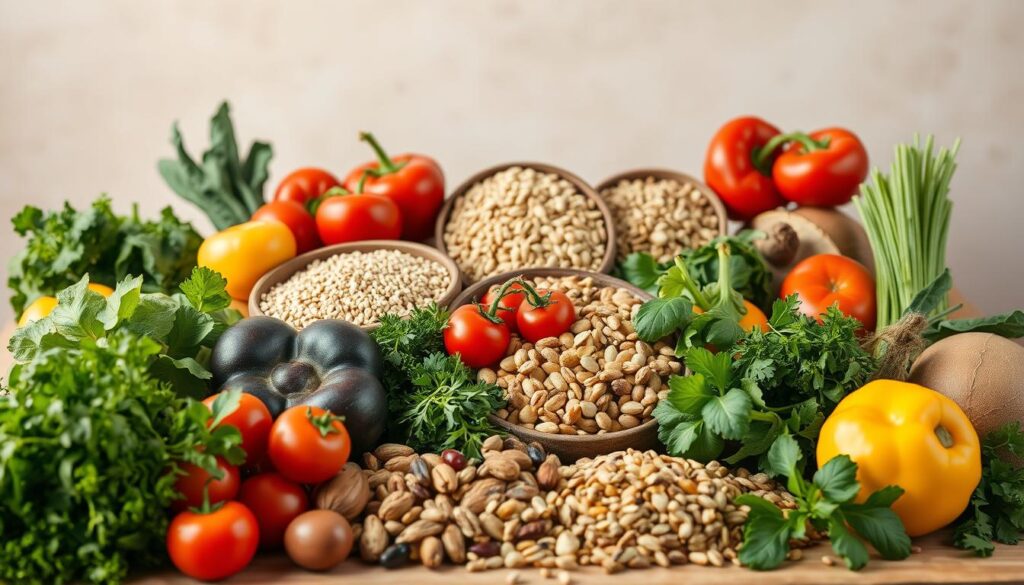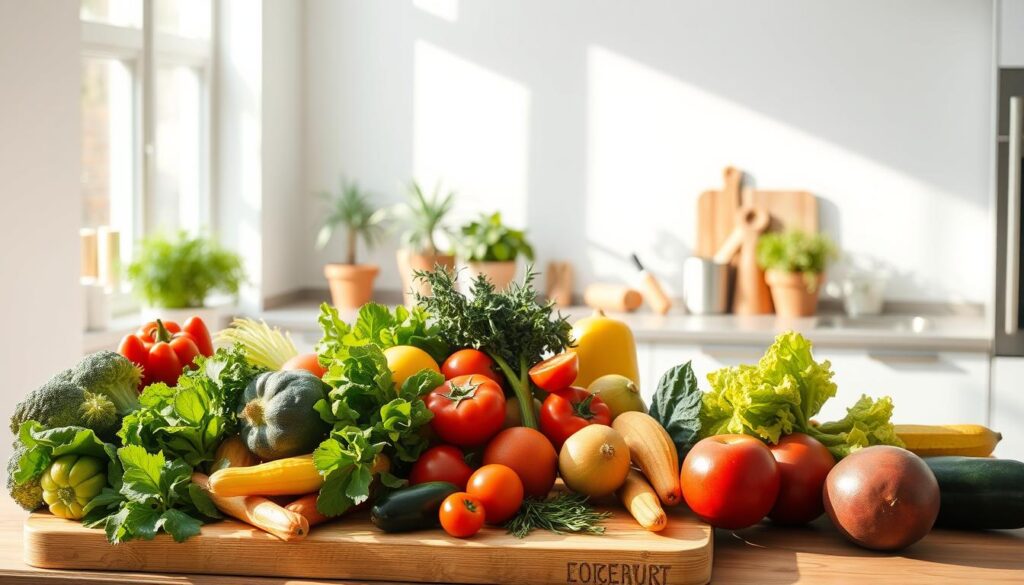Healthy eating is key to a healthy life. Starting small can lead to big changes. The USDA’s MyPlate guide and 2020-2025 Dietary Guidelines suggest eating nutrient-rich foods like veggies, fruits, whole grains, and lean proteins.
Most adults need 2,500 calories a day, while women should aim for 2,000. It’s about giving your body what it needs without strict diets. Choose foods like salmon, leafy greens, and whole grains for energy and wellness.
Healthy habits are about being consistent, not perfect. Make sure each meal has carbs, veggies, and protein. For example, add berries to yogurt or choose carrot sticks over chips.
These steps follow the Mediterranean diet, which promotes whole foods for a longer, healthier life. Even small changes, like drinking water instead of sugary drinks, help your health in the long run.
Key Takeaways
- Balance daily calories: 2,500 for men, 2,000 for women.
- Include 5 portions of fruits/vegetables daily (80g each) and 2 weekly servings of fish like salmon.
- Use MyPlate guidelines to build balanced meals with all food groups.
- Limit ultra-processed foods to reduce risks of heart disease and diabetes.
- Hydrate with water first and make gradual changes, like adding veggies to meals.
Understanding Healthy Eating Habits and Why They Matter
Healthy eating is more than just counting calories. It’s about building a strong foundation for wellness. Every meal affects your energy, mood, and health. The foods you eat power your brain, boost your immunity, and help you handle stress.
The Impact of Food Choices on Overall Wellness
Your body does best with nutrient-rich foods. Whole grains, leafy greens, and lean proteins give you lasting energy. Colorful fruits and veggies are packed with antioxidants that protect your cells.
The World Health Organization says eating more fiber, vitamins, and minerals can lower disease risks. But skipping meals or eating processed snacks can mess with your blood sugar, causing energy crashes and cravings.
Short-term vs. Long-term Benefits of Nutritious Eating
- Short-term perks: clearer thinking, stable moods, and fewer headaches from consistent energy levels.
- Long-term gains: reduced risk of heart disease, stronger bones from calcium and vitamin D, and better weight management.
Breaking the Diet Mentality: Habits vs. Restrictions
“Eating for wellness is a journey, not a quick fix.”
Forget about fad diets that promise fast results. Healthy eating is about finding balance, not cutting out foods. For example, switching to nuts or berries instead of sugary snacks is a smart choice.
WHO data shows cutting down on added sugars can lower obesity risks. Making small changes, like adding spinach to omelets or drinking water instead of soda, can make a big difference over time.
The Building Blocks of Nutrition
Nutrition tips start with understanding the basics. Dietary guidelines suggest a mix of macronutrients—carbs, proteins, and fats—to fuel your body. Let’s break it down simply:

- Carbs: Choose complex options like brown rice, quinoa, and whole-grain bread. They’re your body’s main energy source.
- Proteins: Aim for 56g daily for men and 46g for women. Opt for lean chicken, fish like salmon, or plant-based picks like tofu and lentils.
- Fats: Prioritize unsaturated fats (avocado, nuts, olive oil) and avoid trans fats in fried or processed foods.
Micronutrients like vitamins and minerals work behind the scenes. Leafy greens boost iron, while citrus fruits offer vitamin C. Fiber-rich foods—think broccoli, berries, and beans—aid digestion and keep you full longer. Water matters too: men need 13 cups daily, women 9 cups, to stay hydrated.
“Variety is the spice of life—and your diet.”
Follow dietary guidelines by mixing food groups at meals. For example, pair grilled chicken (protein) with roasted veggies and quinoa. Avoid added sugars in cereals and soda by checking labels for terms like “high-fructose corn syrup.” Small swaps, like swapping fries for sweet potatoes, add up.
Nutrition tips also highlight cost-effective choices: canned beans and frozen veggies save time and money. Prioritize whole foods over highly processed options to get the most nutrients. Your body thrives on balance—no single food holds all the answers.
Creating a Balanced Plate for Optimal Health

Building a balanced diet starts with your plate. Imagine your plate divided into sections. Half should be veggies and fruits, a quarter for whole grains, and a quarter for protein. This method makes nutrition tips simple and doesn’t require counting calories. Let’s look at each part:
Protein: Finding the Right Sources and Amounts
Protein keeps you full and helps muscles grow. Aim for 3-4 oz per meal, about the size of a deck of cards. Choose:
- Lean options like grilled chicken, tofu, or lentils
- Fish twice a week for omega-3s, like salmon or trout
- Beans or eggs for plant-based protein
Carbohydrates: Understanding Complex vs. Simple Carbs
Choose complex carbs that digest slowly. Swap white bread for whole-wheat, or try quinoa instead of white rice. Avoid sugary snacks and choose an apple with peanut butter instead. Your body needs fiber!
Healthy Fats: Essential Nutrients for Your Body
Add fats like avocado slices, a handful of almonds, or a drizzle of olive oil. These support brain health and vitamin absorption. Avoid trans fats in fried or processed foods.
Micronutrients: The Power of Vitamins and Minerals
Colorful veggies like spinach, berries, and carrots pack vitamins A, C, and K. Dairy or fortified plant milk adds calcium. A spinach salad with chickpeas and olive oil hits all categories!
“A balanced plate is your body’s roadmap to energy and vitality.” – USDA MyPlate Guidelines
Small swaps matter: Swap chips for carrot sticks, or top yogurt with berries. Every meal is a chance to nourish your body right.
Mindful Eating: Transforming Your Relationship with Food
Mindful eating changes how you enjoy meals by focusing on the now. It helps you listen to hunger and enjoy food’s taste. Studies show it cuts down on overeating and boosts digestion.
For instance, eating with chopsticks makes meals more enjoyable and helps control portions. Programs like CHEAR’s ROC teach you to listen to your body’s natural hunger and fullness signals. This leads to a better relationship with food.
“Mindful eating involves paying attention to the experience of eating, savoring each bite, and making conscious choices about food consumption.” — National Institute of Health

Recognizing Hunger and Fullness Cues
Pay attention to your body’s hunger and fullness signals. Ask yourself, “Am I hungry or just bored?” Use a 1–10 hunger scale to track your hunger level. Stop eating at 7–8 to avoid eating too much.
CHEAR’s ROC program teaches these techniques. It helps people reconnect with their body’s signals.
Slowing Down: The Art of Savoring Your Food
- Put utensils down between bites to slow your pace.
- Chew thoroughly to enhance digestion and flavor perception.
- Avoid screens or work during meals to stay present and engaged.
Emotional Eating: Identifying Triggers and Healthy Alternatives
Emotional eating often comes from stress or boredom. When cravings hit, try these alternatives:
- Take 10 deep breaths to calm stress.
- Journal your feelings to understand triggers.
- Choose a walk or phone call instead of snacking.
Mindful eating is a skill that grows with practice. Small steps like pausing before eating or using a hunger scale can lead to lasting change. By listening to your body, you’ll enjoy meals more and build a healthier relationship with food.
Smart Meal Planning for Busy Americans
Even with tight schedules, you can still eat well. Healthy meal planning helps families and busy professionals. Spend 30 minutes on Sundays planning meals for the week. Use apps like Plan to Eat or Mealime to make grocery lists easier.

91% of parents report less stress when sharing meals together, according to the American Heart Association.
Here are some easy tips to make your life easier:
- Batch-cook proteins like grilled chicken or lentils for quick weekday dinners.
- Stock a pantry with whole grains, canned beans, and frozen veggies for instant meals.
- Prep snack packs with cut veggies, trail mix, or yogurt cups for on-the-go options.
Check out this table to compare meal prep methods:
| Method | Time | Best For |
|---|---|---|
| Slow cooker meals | 15 mins setup | Hands-off dinners |
| Freezer meals | 2 hrs weekly | Emergency meals |
| One-pot dishes | 30 mins max | Quick lunches |
Use staples like quinoa or chickpeas with pre-marinated meats for fast meals. Label freezer containers by meal type to save time. Small steps make healthy meal planning easy, not hard. Begin with one meal and your future self will be grateful.
Clean Eating Habits for Everyday Life
Starting clean eating habits is easy with small steps. Here’s how to pick healthy foods without making your life harder.

Reading Food Labels Effectively
- Look for ingredients lists with recognizable whole foods like oats, nuts, or spinach.
- Check sugar content: Avoid items with more than 22.5g per 100g—opt for products under 5g for lower sugar.
- Beware of marketing terms like “natural” or “low-fat,” which may hide added sugars or sodium.
Navigating Restaurant Menus and Takeout Options
A 2023 IFIC survey shows 48% of Americans prioritize fresh ingredients when dining out. Try these tips:
- Choose grilled proteins (chicken, fish) over fried options.
- Request dressings and sauces on the side to control portions.
- Split large portions with a friend to avoid overeating.
Healthy Swaps for Common Food Cravings
| Craving | Swap |
|---|---|
| Salty chips | Roasted chickpeas or carrot sticks with hummus |
| Sugar cravings | Dark chocolate (70% cocoa+) or frozen grapes |
| Fast food burgers | Grilled chicken wrap with lettuce instead of a bun |
Remember: Small changes add up! Track progress with a food diary to spot patterns and celebrate wins like choosing water over soda. Balance is key—enjoying a treat occasionally keeps habits sustainable.
Adapting Your Diet for Different Life Stages and Needs
Life changes, and so do your nutritional needs. Following dietary guidelines helps keep your balanced diet in sync with your body. Whether you’re growing up or getting older, making the right food choices is key for your health.

- Adolescence: Focus on iron, calcium, and protein for growth. Eat leafy greens, lean meats, and fortified cereals.
- Pregnancy: Increase folic acid with dark greens and prenatal vitamins. Add omega-3s from salmon or walnuts.
- Middle Age: Eat more fiber and omega-3s for heart health. Choose whole grains over refined carbs.
- Senior Years: Eat protein like Greek yogurt or lentils to keep muscles strong. Talk to your doctor about B12 supplements.
Drinking enough water is important at every age. Try water, herbal teas, or low-fat milk. Programs like SNAP and CSFP help get fresh produce. The core of a balanced diet is whole foods, with adjustments for age.
Men need about 2,500 calories a day, women 2,000. But focus on nutrient-rich foods, not just calories. For example, older adults might need smaller portions but more vitamins. Stay away from empty calories in sugary snacks or fried foods.
See a dietitian for a diet plan that fits you. Small changes, like swapping white rice for quinoa or adding spinach to smoothies, can make a big difference. Your health journey is a lifelong adventure, and being flexible makes it sustainable.
Overcoming Common Obstacles to Healthy Eating
Making healthy eating habits last isn’t always simple. Issues like cost, time, and social pressures can seem too much. But, taking small, steady steps can help turn these obstacles into chances for growth.

Budget-Friendly Nutrition Strategies
You don’t have to spend a lot to eat well. The U.S. Department of Agriculture suggests programs like Spend Smart-Eat Smart for budget-friendly recipes and advice. Here are some tips:
- Choose seasonal fruits and veggies like bananas, carrots, and apples—they’re cheaper and taste better.
- Buy store-brand items like grains and canned beans when they’re on sale.
- Use bulk bins for nuts, oats, and dried fruit to save money.
Time Constraints: Quick and Healthy Options
Short on time? Focus on smart preparation:
- Prepare grains or soups in bulk on weekends for quick meals during the week.
- Keep easy-to-grab foods like pre-cut veggies, hard-boiled eggs, or Greek yogurt cups ready.
- Try quick meals like stir-fries or whole-grain pasta with veggies that take just 15 minutes.
Social Situations and Family Dynamics
At social events, make balanced choices. Bring a healthy dish to share, like a veggie tray or a whole-grain salad. When eating out, ask for healthier options like grilled proteins instead of fried ones. Remember this:
“Enjoy favorite foods in moderation—savor small portions without guilt.”
Every challenge has a solution. Small actions, like adding more veggies to a meal or choosing water over soda, can lead to lasting healthy lifestyle habits. Focus on progress, not perfection.
Conclusion: Embracing a Lifelong Journey of Nourishing Your Body
Healthy eating is not about being perfect. It’s about making progress. eating for wellness begins with small, doable steps. Try swapping refined grains for whole oats or adding chia seeds to your yogurt.
Every choice you make, like choosing Nature Jim’s sprouts over chips, adds up. Remember, adopting healthy habits takes time. Start with small goals, like adding berries to your morning or trying fiber-rich snacks.
Science backs up the benefits of these choices. They can lower disease risks and improve your mental clarity. Celebrate your successes, like drinking water instead of soda. And don’t be too hard on yourself if you slip up.
Flexibility is key. Swap ingredients or share meal prep tips with friends to stay on track. True nourishment is about fueling your body with good foods and enjoying meals fully.
Over time, these habits will give you energy, longevity, and joy. Your journey is unique. Keep learning, be kind to yourself, and let every meal be a step toward a vibrant life.



